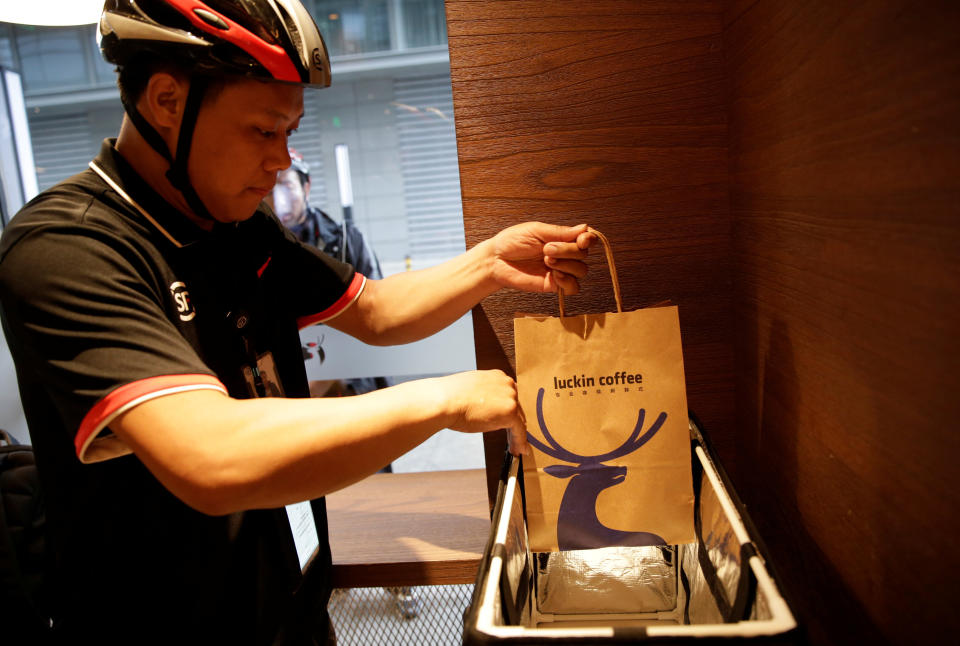What you need to know about Luckin Coffee on its IPO day
Luckin Coffee (LK) has sold millions of cups of coffee to Chinese consumers. Now it wants to sell its business model to U.S. investors.
The Chinese coffee chain made its debut on the Nasdaq Friday and saw its shares open at $25 a share, up 47% from its IPO price of $17. It later got as high as $25.96 before settling at $20.38 for the day, a respectable gain of 20%.
The 22-month-old company has achieved rapid growth through building out physical stores, launching widespread marketing campaigns and offering generous subsidies.
While it is seen as a rival to Starbucks (SBUX), the company has a different strategy in appealing to young consumers in China, and bears major profitability issues beneath all of its exponential growth.
Here is what you need to know about Luckin.
Luckin opens a new store every five hours
Starbucks, the Seattle-based coffee chain, announced an ambitious plan to expand in China in 2017 — to open 6,000 stores in China by 2023. Now it has over 3,700 locations.
But the speed of Luckin overshadows the giant’s efforts to capture the Chinese market. Since October 2017, Luckin opened 2,370 locations within 18 months, that means it set up a new store every five hours.

There are also some key differences between a typical Starbucks store and a Luckin store. Starbucks aims to provide a “Third Place” experience in which people sit down and chat while sipping coffee. Luckin stores, however, usually act as pickup points and delivery hubs. These stores range from 20 to 60 square meters, which means it’s much cheaper for Luckin to build new store fronts and the format is easy to copy in different locations.
Focus is on delivery and pickup
Pickup stores with limited seating account for over 90% for Luckin’s total stores. These stores are typically located in office buildings, commercial areas and university campuses. Its network of stores highlight the other focus of Luckin — fast delivery.
Thanks to high population density and cheap labor cost, China’s millennial shoppers, especially in major cities, live on delivery, from food to groceries, and of course, the afternoon coffee. Meanwhile, busy work schedules like the notorious “996 shift” keep employees in the office, instead of hanging out in a coffeeshop.

With a loyal fan base, Starbucks has been ignorant in the trend, until the rise of Luckin becoming wake-up call. Luckin features an app that you can order and get coffee delivered to the office within an average of 17 minutes, according to the company. Starbucks announced a partnership with Alibaba’s (BABA) delivery arm Ele.me in September 2018 and that partnership has expanded to more than 2,100 stores.
Profitability is questionable
Luckin reported total revenue of $125.3 million for 2018 by serving 16.8 million customers. But that growth came at a cost— a net loss of $241.3 million for 2018, to be exact. Users have been attracted to Luckin for its aggressive marketing campaign on WeChat, the prevalent social media in China, and promotions like “Buy 5 and Get 5” and 92%-off coupons. Luckin relies on third-party companies to ensure ultra-fast delivery.
This also poses the question of, if the subsidies are gone, will customers stay? Some numbers revealed in Luckin’s S1 filings have investors second guessing the company’s strategy. While Luckin says the cost of acquiring each new customer, including marketing and promotions, has fallen by nearly 85% since the start of 2018, its new customers also dropped to 4.3 million this year from 6.5 million in the final three months of 2018
But Luckin warned that losses may increase as it aims to overtake Starbucks to be the largest coffee chain, based on number of stores, by the end of this year.
“We intend to further increase our brand awareness, expand our customer base and store network, and expect to continue to invest heavily in offering discounts and deals and other aspects of our business, especially sales and marketing expenses, in the foreseeable future as we continue to expand our store network and our product offerings,” Luckin wrote in its S1 filings.
Write to Krystal Hu via [email protected] or follow her on Twitter.
Read more:
Jack Ma to Alibaba employees: Have more kids
Here are all of Uber's worldwide competitors
Huawei is still winning 5G contracts around the world despite the U.S. ban
